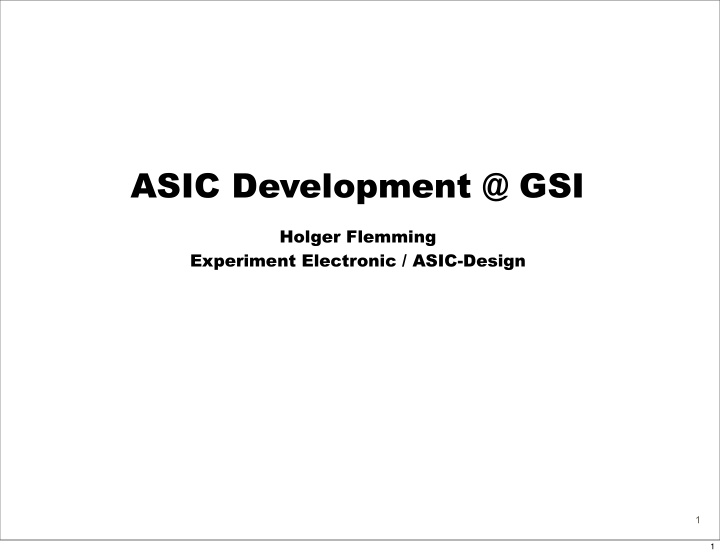



ASIC Development @ GSI Holger Flemming Experiment Electronic / ASIC-Design 1 1
The GSI ASIC Design Group • Since 2002 part of experiment electronics department • 5 Team members • 4 designer • 1 technician • CAD tools (via Europractice) • Cadence Design Framework II ( Full Custom Analog and Digital Design) • Mentor Graphics Calibre (verification), ModelSim (digital simulation) • Synopsys Design Compiler (digital synthesis) • Cadence SOC Encounter (Place and Route of digital designs) • Bond-Lab • Die-Bonder • Wire-Bonder • Manuel Prober • Electronics Lab Holger Flemming, GSI, EE 2 Silicon Multiplier WS 10/2011 2
Preamplifier and Shaper ASIC: APFEL • A SIC for P ANDA F ront end El ectronics • Readout of the electromagnetic calorimeter of the PANDA - detector • 11000 lead tungstate crystals read out by two large area avalanche photo diodes each • Requirements: • Preamplifier and shaper • Input matched to the avalanche photo diodes, detector capacitance 300 pF • Low noise • Large dynamic > 10000 • Pulse rate: > 300 kHz • Peaking time: 250 ns • Power consumption: < 50 mW/ch • Environmental temperature: -25 °C Holger Flemming, GSI, EE 3 Silicon Multiplier WS 10/2011 3
The APFEL - ASIC • 350-nm-CMOS-technology by AMS • 2 poly- and 4 metal layer • Supply voltage: 3,3 V • 2 channels on: 3,3 × 3,4 mm^2 • Noise @ 280 pF / -25 °C: 4248 e = 0,68 fC • Upper limit of dynamic range: 6,89 pC • Dynamic range: 10140 Holger Flemming, GSI, EE 4 Silicon Multiplier WS 10/2011 4
Study on Radiation Effects • Characterisation of the UMC 180 nm CMOS technology regarding: • Cross sections of single event effects • Single Event Transients • Single Event Upsets • Total Ionising Dose Effects of single transistors Test chip GRISU • Threshold shift • Increasing of leakage Bestrahlungsplatz X6 Holger Flemming, GSI, EE 5 Silicon Multiplier WS 10/2011 5
Cross Section C-12 Ar-40 Ni-58 Ru-96 Xe-132 • LET crit = 1,93 MeV cm ² /mg • σ sat = 1,48 · 10 -8 cm ² /bit Holger Flemming, GSI, EE 6 Silicon Multiplier WS 10/2011 6
The GSI Event driven TDC GET4 • Developed for the CBM Time of Flight Detector • Requirements from CBM: • Time resolution • System < 80 ps • TDC < 25 ps • Event rate > 50 kHz / Ch • Power consumption 60 mW / Ch • FEE : 30 mW / Ch • TDC : 30 mW / Ch • Double pulse resolution < 5 ns • Number of channels ~65000 • „Time over Threshold“ measurements • Data acquisition event driven Holger Flemming, GSI, EE 7 Silicon Multiplier WS 10/2011 7
GET4 Overview 50 ps binning counter for timestamps FIFO as buffer for up to 12 events Readout with a serial interface. Mean event rate the GET4 can cope with is encoder can cope with 1 event / 3,2 ns given by data rate: ⇒ burst rate: 320 MHz 20 MBit/s for 100 kHz/ch Holger Flemming, GSI, EE 8 max. tested bit rate: 312 MBit/s => 1.56 MHz/ch Silicon Multiplier WS 10/2011 8
The GET4 ASIC • 180-nm-CMOS-technology by UMC • 1 poly and 6 metal layer • Supply voltages: • Core: 1,8 V • IO : 3,3 V • Size: 3,24 × 3,24 mm^2 • Power consumption: 30 mW/ch GET4-ASICs Holger Flemming, GSI, EE 9 Silicon Multiplier WS 10/2011 9
Measurement Results of GET4 & PADI • Preamplifier and Discriminator PADI developed by M. Ciobanu @ GSI • Preamplifier for low impedance differential detectors • RPC detectors @ CBM-ToF • Time resolution PADI & GET4 ~ 21 ps (1 Channel uncorrelated) • Pulse width < 1 ns resolvable Holger Flemming, GSI, EE 10 Silicon Multiplier WS 10/2011 10
Current Developments • Currently the next iteration of GET4 is under development (GET4-V1.0) • More efficient floor planning • Improved TDC core • Epoch counter • DLL lock state flag in data stream • Channel masking • Internal test pattern generator • I2C and / or SPI Master • Tape out foreseen for end of 2011 / early 2012 • CPU controlled readout controller • Aim: Reduction of serial links and readout hardware • Features: Buffering of event data, frame building, daisy chain readout • First test chip designed in 2010 Holger Flemming, GSI, EE 11 Silicon Multiplier WS 10/2011 11
The GPRC1 Holger Flemming, GSI, EE 12 Silicon Multiplier WS 10/2011 12
Recommend
More recommend